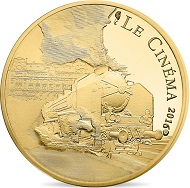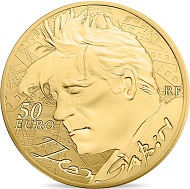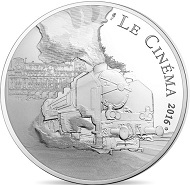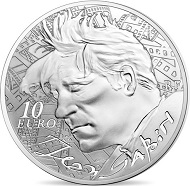January 19, 2017 – In 2016 France issues the 4th coin of its ‘7 Arts Series’ dedicated to the famous actor Jean Gabin who died 40 years ago. The series is designed by Christian Lacroix.
France / 50 euros / .920 gold / 22 mm / 8.45 g / Mintage: 500.
On the reverse, the drawing of the face of Jean Gabin, on a background textured, with the name and the face value. In the background, an accumulation of film tape representing the 7th art. On the obverse of this coin, we can see the year date and the inscription of the art, the cinema, honored by this coin. The Saint Lazare station appears in the background, famous place where part of the movie ‘La Bête Humaine’ takes place. In the foreground, Lison, the Pacific 231 steam locomotive driven by Jacques Lantier in the movie.
Jean Gabin and Michèle Morgan in ‘Le Quai des brumes’, 1938.
Jean-Alexis-Gabin Moncorgé
Jean-Alexis-Gabin Moncorgé was born in Paris in 1904. His father was an actor, and his mother a singer. He was raised in the countryside by her older sister. At 18, he entered in the world of the show amount onstage at the Folies Bergères before his military service. In 1928 he made his first steps in the cinema and played in films amongst the famous French film such as ‘La Grande Illusion’, ‘Gueule d’Amour’ with Mireille Balin (1937), ‘Le Quai des Brumes’ with Michèle Morgan, ‘La Bête Humaine’ (1938), ‘Le Jour se Lève’ (1939).
In September 1939, Gabin is mobilized, and in February 1941, after demobilization, he refuses to play for the Germans and leaves for the United States where he makes two films. In 1943, Gabin enlists in the Forces Françaises Libres and is presented with the Médaille Militaire and the Croix de Guerre. He directed many films before passing away in 1976. His career is marked by collaborations with notably Michel Audiard, Louis de Funès, Bourvil, Jean-Paul Belmondo or Alain Delon. He is part of the French players having attracted the largest number of viewers in cinemas: about 161 million between 1946 and 1976.
France / 10 euros / .900 silver / 37 mm / 22.2 g / Mintage: 5,000
Paris-Saint-Lazare Station, also known as Saint-Lazare station, is one of the six large terminus of the SNCF network stations in Paris. Located in the area of Europe in the 8th arrondissement, it was one of the major lines of the West-State network. First station built in île-de-France as early as 1837 and assigned mainly for commuter traffic, it is the second station of Paris and France through its traffic and the second in Europe, with about 100 million travelers per year. The Saint-Lazare station occupies a prominent place in French culture. First of all, it is a popular source of inspiration for the Impressionists during the end of the nineteenth century, technical progress has become the new theme to study. Thus, Monet and Caillebotte dedicate a part of their work to this station. In addition, since 1985, works of art ‘accumulations’ of the French painter and sculptor Arman, five meters high, were placed in two courtyards from the railway station: ‘Consigne à vie’, representing a stack of suitcases, and ‘L’Heure de tous’, representing a stack of clocks in the courtyard of le Havre.
Finally, at the cinema, ‘La Bête Humaine’, a French film directed by Jean Renoir, and adapted from the eponymous novel by Émile Zola in 1938 takes place partly in Paris-Saint-Lazare station and its surroundings. The main character, Jacques Lantier, played by Jean Gabin, made the line Paris -Le Havre from Saint-Lazare station.
The 7 Arts
From the classical Antiquity, a distinction is made between different arts, incarnated by Muses. According to Plato for example, each art has iconographic features: Clio, muse of History, can be recognized by her laurel crown, her swan and the book or roll she holds in her hand. Nowadays, the division of the arts is most commonly as follows:
- Architecture
- Sculpture
- Drawing
- Dance
- Music
- Literature & Poetry
- Cinema
The 8th art, that can be, according to context, radio or television, and a 9th art, comics or video games are added sometimes.
The artist: Christian Lacroix
Since 2010, Christian Lacroix is the artistic advisor of Monnaie de Paris. He has designed the ‘Médaille du Mariage’ (Wedding Medal) and the ‘Médaille du Pacs’ (Civil Union Medal), as well as the coin series on French Kings and heads of state. He was also part of the stage design of an exhibition in Bordeaux, co-organized by Monnaie de Paris and the Museum for decorative arts in Bordeaux in 2013.
‘Coins are a vehicle for tradition and innovation; it is both reassuring and surprising, as there can be no contemporary creativity without boldness, a guarantee of modernity and elegance, a combination that contains a touch of that mystery known as “French taste”, Parisian, unique and eternal because it’s indefinable. Madame Grès said poetically that the sky above the Seine was the secret responsible for this national treasure. From Monnaie de Paris, we have a stunning view of this shared wonder.’ Christian Lacroix, Artistic advisor of Monnaie de Paris
The ‘7 Arts Series’: an art, an artist, a place
From the first coin of the series, Mr Lacroix created a pattern for each side of the coin. On the reverse, a drawing of the artist’s face, over a texturized background, with the artist’s name and the face value. On the obverse, a mix of several symbols of the year’s theme, the year date, the mintmarks, and the name of the celebrated art.
Dance: Rudolf Noureev (died in 1993 / 20th aniversary) / Opéra Garnier / 2013
Music: Jean-Philippe Rameau (died en 1764 / 250th aniversary) / ‘Les Indes Galantes’ / 2014
Architecture: Le Corbusier (died in 1965 / 50th aniversary) / Cité Radieuse / 2015
Cinema: Jean Gabin (died in 1976 / 40th aniversary) / Paris / 2016
Sculpture: Auguste Rodin (died in 1917 / 100th aniversary) / Musée Rodin / 2017
Literature & Poetry: Guillaume Apollinaire (died in 1918 / 100th anniversary) / Paris / 2018
Painting: Pierre Soulages (born in 1919 / 100th aniversary) / Centre Pompidou / 2018
To learn more about the series go to the Monnaie de Paris website.
There is also a museum dedicated to Jean Gabin. Visit its website here.









